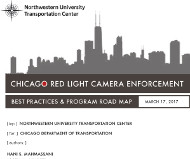3/21/2017
Study Touts Red Light Camera Benefits In Chicago, IllinoisChicago, Illinois agrees to increase red light camera grace time in light of report on program.

Chicago, Illinois has the nation's single-most lucrative red light camera program. To defend it in the wake of a criminal fraud scandal involving the number two man at the city's transportation department, the Chicago Department of Transportation hired the Northwestern University Transportation Center to produce a report that would showcase the benefits of the program that generated $45,462,700 worth of tickets in 2015. The city released the document on Monday.
"Demonstrating the effectiveness of automated enforcement programs, in this case the red light camera program, is obviously essential to gain community support," the Northwestern researchers wrote. "That requires the kind of data collected and analyzed in this study."
The university is the recipient of over $3.2 million in city contracts, so its researchers were eager to assist in a camera program makeover. The study examined alleged red light camera violation data from 85 intersections between 2010 and 2015. The study calculated that there was a 14 percent increase in rear-end accidents but a 10 percent reduction in accidents overall. Nearby cities without cameras, however, saw a greater reduction in accidents -- 15 percent overall. The researchers explained the discrepancy by asserting the existence of a "spillover effect."
"As we have observed an increase in rear-end crashes in Chicago, whereas a decrease in the neighbor cities [without cameras], we assume that the entire increase in rear-end crashes is due to spillover effect," the researchers asserted.
The report also concluded that signal timing played a major role on violations.
"An immediate concern lies with violations within a fraction of a second into the red phase," the report explained. "Legitimate dilemma zones at the onset of the yellow do occur, especially at higher speed intersections, and may be difficult to eliminate completely without substantially longer intervals. In addition, the electrical technology behind traffic signal controllers may itself produce slight variations in the actual duration of the yellow interval. Public perceptions of fairness diminish when otherwise well-meaning, law-abiding drivers are effectively caught in the dilemma zone. The effect of the dilemma zone is evidenced by the significant reduction in violations when the yellow interval is 4 seconds compared to 3 seconds."
Rather than increase yellow timing, the city agreed to bolster its image by ordering its private camera vendor to only issue tickets when a picture is taken 0.3 seconds after the light turns red. Though it seems like a small change, the move would have reduced revenue by $15 million over the last five years. By comparison, Virginia law mandates the grace period be at least 0.5 seconds.
A copy of the report is available in a 3mb PDF file at the source link below.


